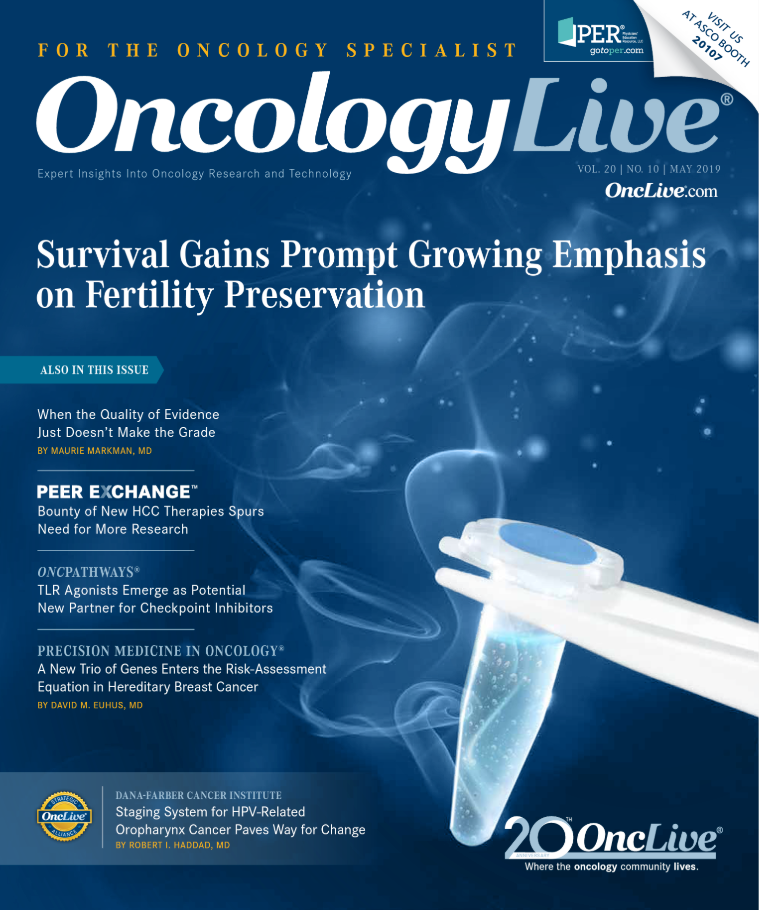Staging System for HPV-Related Oropharynx Cancer Paves Way for Change
A new staging system for head and neck cancers recognizes that patients with oropharyngeal malignancies associated with the human papillomavirus often have an excellent prognosis, but efforts to deintensify therapy for this population based on a fresh understanding of favorable risk factors may be premature.

Robert I. Haddad, MD
Division of Head and Neck Oncology Dana-Farber Cancer Institute
Professor of medicine
Harvard Medical School
Boston, Massachusetts
A new staging system for head and neck cancers recognizes that patients with oropharyngeal (OP) malignancies associated with the human papillomavirus (HPV) often have an excellent prognosis, but efforts to deintensify therapy for this population based on a fresh understanding of favorable risk factors may be premature.
Study findings have established HPV-related oropharyngeal (HPVOP) cancer as a distinct and well-defined clinical and pathological entity within head and neck cancers. It is caused by infection with high-risk HPV—most commonly, HPV16, the same causative virus for cervical and anal cancer. Overexpression of the protein p16, detected by immunohistochemistry, is the recommended test for all patients with OP cancer and an excellent biomarker for HPV infection.
Compared with smoking-related OP cancers, HPVOP cancers occur in younger and healthier patients who are typically nonsmokers.1 The most common presentation for HPV-related cancers is a large cystic node in the neck with a small primary site. It is important to note that HPV infection occurs primarily in the oropharynx (ie, tonsil and tongue base) and infection with the HPV virus outside of the oropharynx (eg, oral cavity and larynx) can occur, but its significance is unknown at this stage. The number of patients affected with HPVOP cancer has increased dramatically over the past 25 years for reasons not yet fully understood.
Patients with HPVOP cancer are also distinct prognostically from those with smoking-related cancers. It is well recognized now that HPVOP cancers are well-behaved tumors with survival rates that exceed 80% even in patients with locally advanced disease.2 The old staging system was felt to be poorly representative of HPVOP cancer, and this led to the development of a new staging system, the eighth edition of the American Joint Committee on Cancer Staging Manual, Head and Neck Section (AJCC 8th Edition), designed specifically for these patients.3 The new staging system includes a chapter that specifically covers p16-positive OP cancer (Figure3).
The AJCC 8th Edition has major differences from the seventh edition in that it incorporates separate clinical and pathological nodal staging system and stage groups. Patients with OP cancers are somehow unique in the realm of head and neck cancers because for most patients with T1 and T2 disease, a surgical or nonsurgical option is available, creating a situation where patients could be staged either clinically or pathologically. This is unlike oral cavity cancers, for example, for which most patients are treated surgically first, and larynx cancer, for which most patients are treated nonsurgically. AJCC 8th Edition is a game changer from a practical standpoint; most patients treated prior to its implementation were classified as stage IVa disease based on the presence of 1 or more neck nodes, whereas in the current system, these patients with p16-positive disease fall into stage I or II. In the new system, stage IV is applied only to distant metastatic disease.
Deintensification Strategies are Tested
The excellent prognosis noted in patients with HPVOP cancer has led to the emergence of a treatment approach called treatment deintensification. This concept refers to reducing the “intensity” of therapy for these patients given their excellent outcomes. It will be useful to review the standard treatment here and how this could be affected in the future.
As noted, patients with OP cancer can be treated surgically first, with postoperative therapy determined by pathological findings. Positive margin or extranodal extension of disease would usually require concurrent cisplatin-based chemoradiotherapy. Alternatively, these patients can also be treated with up-front cisplatin-based chemoradiotherapy without surgery. The standard cisplatin dose is 100 mg/m2 given once every 3 weeks.
The use of surgery, radiation, and chemotherapy has lifelong and well-known consequences for the patient. Reducing the intensity of therapy can theoretically lead to better functional outcomes, assuming overall survival is maintained. Deintensification strategies have taken different forms:
1. Reducing radiation therapy dose from 70 Gy to 50 or 60 Gy
2. Omitting chemotherapy from treatment regimens and using radiation alone as an alternative to chemoradiotherapy
3. Using surgery or induction chemotherapy as a “screen” to determine next line of therapy
It is important to note that treatment deintensification is experimental and should not be performed outside of a clinical trial. Given the excellent prognosis seen with the current standard therapies, any deviation from this standard should be well explained to the patient with proper consent documentation.
Clinical Trial Findings Vary
The first attempt at deintensification occurred through the Intergroup ECOG 1308 study.4 In this small phase II study involving 80 patients, participants with locally advanced p16-positive OP cancer were treated with induction chemotherapy, first with 3 cycles of cisplatin, paclitaxel, and cetuximab (Erbitux). Patients with a clinical complete response (CR) to the primary site received lower-dose intensity-modulated radiation therapy (IMRT) at 54 Gy with weekly cetuximab (deintensification group). Those who did not achieve a CR received standard-dose IMRT with cetuximab. This small study confirmed this approach to be feasible in an intergroup setting, with best outcomes noted in a subgroup of patients (n = 27) with with less than T4, less than N2c, and less than or equal to 10 pack-year smoking history who were treated with low-dose radiation. At 12 months, significantly fewer patients treated with the low radiation dose had difficulty swallowing solids or had impaired nutrition, making the case for deintensification as a mechanism to decrease the overall toxicity of the treatment.
Subsequently, ECOG initiated and has now completed E3311, a large study in which patients with p16-positive OP cancer were treated surgically first and assigned to various groups post surgery based on pathological findings. Chemoradiotherapy was reserved for patients with positive margins or frank extranodal extension. The results are still being analyzed.5
Two large, recently published studies showed surprising results and should serve as a reminder of the importance of applying extreme caution with deintensification. These investigators attempted deintensification by using cetuximab instead of cisplatin, given the perceived low toxicity with cetuximab and high toxicity with cisplatin. The first study, RTOG 1016, is a noninferiority trial comparing radiotherapy plus cetuximab with radiotherapy plus cisplatin in patients with HPVOP cancer.6 This large phase III study enrolled 987 patients and, after a median follow up of 4.5 years, radiotherapy plus cetuximab did not meet the noninferiority criteria for overall survival. The estimated 5-year overall survival was 77.9 % in the cetuximab group versus 84.6% in the cisplatin group. Progression-free survival was significantly lower and locoregional failure was significantly higher in the cetuximab group compared with the cisplatin group.
Figure. Defining HPV-Associated Oropharyngeal Cancer3
The second study, De-ESCALaTE HPV from Europe, compared radiation plus cisplatin with radiation plus cetuximab in patients with low-risk HPVOP.7 The study enrolled 334 patients and showed significantly worse tumor control with cetuximab plus radiotherapy and no benefit of reduced toxicity. The results of these 2 studies suggest a clear benefit for bolus cisplatin in these patients and, in the setting of up-front nonsurgical treatment, the omission of cisplatin is not acceptable in locally advanced disease.
Conclusions
In summary, cancer specialists should be aware of the new staging system implemented for HPVOP cancer in 2018. We should continue to be mindful that this cancer is highly curable with the current treatment standards using a combination of chemotherapy, radiotherapy, and surgery.
The rush to deintensification should take note of the recent publication of RTOG 1016 and De-ESCAaTE HPV findings. These results remind us that most of the data we have on the excellent prognosis in these patients come from chemoradiotherapy trials using standard dosing and schedules. A deviation from these standards should be thoughtful and careful so that we can maintain and possibly improve overall survival.
References
- D’Souza G, Kreimer AR, Viscidi R, et al. Case-control study of human papillomavirus and oropharyngeal cancer. N Engl J Med. 2007;356(19):1944- 1956. doi: 10.1056/NEJMoa065497.
- Ang KK, Harris J, Wheeler R, et al. Human papillomavirus and survival of patients with oropharyngeal cancer. N Engl J Med. 2010;363(1):24-35. doi: 10.1056/NEJMoa0912217.
- Lydiatt WM, Patel SG, O’Sullivan B, et al. Head and neck cancers-major changes in the American Joint Committee on Cancer eighth edition cancer staging manual. CA Cancer J Clin. 2017;67(2):122-137. doi: 10.3322/caac.21389.
- Marur S, Li S, Cmelak AJ, et al. E1308: phase II trial of induction chemotherapy followed by reduced-dose radiation and weekly cetuximab in patients with HPV-associated resectable squamous cell carcinoma of the oropharynx- ECOG-ACRIN Cancer Research Group. J Clin Oncol. 2017;35(5):490-497. doi: 10.1200/JCO.2016.68.3300.
- National Clinical Trials Network. E3311: phase II randomized trial of transoral surgical resection followed by low-dose or standard-dose IMRT in resectable p16+ locally advanced oropharynx cancer. ECOG-ACRIN Cancer Research Group website. ecog-acrin.org/wp-content/uploads/ 2016/10/E3311_PFS_081516.pdf. Updated August 15, 2016. Accessed April 16, 2019.
- Gillison ML, Trotti AM, Harris J, et al. Radiotherapy plus cetuximab or cisplatin in human papillomavirus-positive oropharyngeal cancer (NRG Oncology RTOG 1016): a randomised, multicentre, non-inferiority trial. Lancet. 2019;393(10166):40-50. doi: 10.1016/S0140-6736(18)32779-X.
- Mehanna H, Robinson M, Hartley A, et al; De-ESCALaTE HPV Trial Group. Radiotherapy plus cisplatin or cetuximab in low-risk human papillomavirus-positive oropharyngeal cancer (De-ESCALaTE HPV): an open-label randomised controlled phase 3 trial. Lancet. 2019;393(10166):51-60. doi: 10.1016/S0140-6736(18)32752-1.

Latest Conference Coverage

Navigating the Intersection of Radiation Therapy and Immunotherapy in Endometrial Cancer

As Orthopedic Oncology Evolves, Caring for the Clinician Must Be a Priority

Belumosudil Produces Long-Term Responses Without New Safety Concerns in cGVHD

Prophylactic Itacitinib May Safely Mitigate CRS Following Axi-Cel Administration in Lymphoma
2 Commerce Drive
Cranbury, NJ 08512